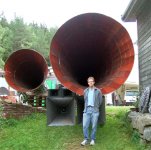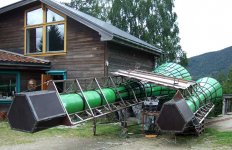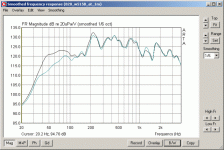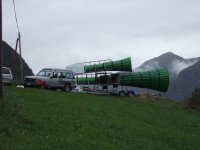That's why I'm interested in the OmniTop 2x12 - simple is better when it comes to the time domain. The DR280, or any curved horn, has an esthetic appeal, but trying to persuade sound waves to travel around a gradual 180-degree bend is going to have interesting effects on the time response. The path length appears to be something like 36~40 inches, which would mean the AH425 has to sit way back or use digital time-delay compensation.
By contrast, the OT12 and OT15 are short, simple conical horns with a small phase-plug for the driver and a moderate-size vented rear chamber. All of the cabinets have extensive cross-bracing in the interior, with no free unsupported areas much larger than 7 inches. I might end up with something completely different, but building, measuring, and listening to these should be educational.
For one thing, I've never heard a system with 105+ dB/metre efficiency and flat (unequalized) response before - I have no idea what that would sound like. Usually, in the hifi world, we have to choose between the crispness and clarity of high-efficiency, but put up with obvious colorations and rough response, or choose the smoothness and low coloration of low efficiency direct-radiators, and give up the "directness" and immediacy of high-efficiency systems. There has to be a middle ground somewhere between the two.
By contrast, the OT12 and OT15 are short, simple conical horns with a small phase-plug for the driver and a moderate-size vented rear chamber. All of the cabinets have extensive cross-bracing in the interior, with no free unsupported areas much larger than 7 inches. I might end up with something completely different, but building, measuring, and listening to these should be educational.
For one thing, I've never heard a system with 105+ dB/metre efficiency and flat (unequalized) response before - I have no idea what that would sound like. Usually, in the hifi world, we have to choose between the crispness and clarity of high-efficiency, but put up with obvious colorations and rough response, or choose the smoothness and low coloration of low efficiency direct-radiators, and give up the "directness" and immediacy of high-efficiency systems. There has to be a middle ground somewhere between the two.
Last edited:
Usually, in the hifi world, we have to choose between the crispness and clarity of high-efficiency, but put up with obvious colorations and rough response, or choose the smoothness and low coloration of low efficiency direct-radiators, and give up the "directness" and immediacy of high-efficiency systems. There has to be a middle ground somewhere between the two.
There has been a middle ground for years. There are several posts in this thread (yes, a couple of years ago!)
By contrast, the OT12 and OT15 are short, simple conical horns with a small phase-plug for the driver and a moderate-size vented rear chamber.
Can you divulge/reffer to any details about this phaseplug? In any depiction of the OmniTop I've seen, the cone seemed to radiate directly into the horn. If indeed the Omnitop has a real phase-plug then this might be the secret of it's behaviour in the time domain.
I try to avoid considering cones with anything but foam in front of them mainly because I believe that a) cone design is sub-optimal to accurately design a phaseplug. Consider compression drivers: the distance between the phase-plug and the diaphragm is minimal and doesn't change a lot when in use; And b) even compression driver phase-plug tech is not that well well grasped. Mr's Geddes patents on this subject for example reveal some of the shortcommings.
Nevertheless, I find Omnitops even more interesting because of these aspects.
For one thing, I've never heard a system with 105+ dB/metre efficiency and flat (unequalized) response before - I have no idea what that would sound like.
Well, for sure it will sound and feel loud! Probably the same experience as described by owners of Summa loudspeakers: that feeling that you can crank out the volume on and on. It will be quite a leap from your 92dB Ariel.
@TrueSound
The only way you'll get "directness" is with 102-103db + sensitivity all the way down in the 40 - 50 cycle range. A shortened horn, folded horn or a vented horn is not going to do it
I know Magnetar was saying the same thing. After building lots of different system configuration (direct, horn, arrays, etc.), he stated that you get a sense of directness only when passing 103 dB.
Now, the Omnitops should do it. Two per side are about 105dB, the Azura with the CD selected by Mr. Olson is probably a couple of dB more sensitive, around 109 dB.
My Norwegian friend Bjorn Kolbrek sent me some pics and text about this modest little project:
I think even Truesound would agree the bass horn is adequately large for the task. If you ever wondered what Norwegians do during those dark winter months, well, now you know.
BTW, last weekend, I tuned up an insane horn system that I have helped design. I don't have time to explain much about it now, but it had a very nice bass. The big horn has good response down to 15Hz. It is 9.2m long, and the mouth is 2.4m across. It's yours truly standing in front of it to give you an idea of the scale of the thing. The system is 3-way, and covers 15Hz-15kHz, and sounds remarkably good, very clean too, even at loud volumes and large distances. Playing organ music on it was cool. You could hear the quality of the bass far away, and the sound was balanced even 1.5km away.
I think even Truesound would agree the bass horn is adequately large for the task. If you ever wondered what Norwegians do during those dark winter months, well, now you know.
Attachments
Last edited:
Well can you tell us something about their sound? I see those are strapped to an amplifier.
edit: regarding stacking two Omnitops 12, I like this configuration here: 2xOmnitop 12
This way you can even try and round the edges..
edit: regarding stacking two Omnitops 12, I like this configuration here: 2xOmnitop 12
This way you can even try and round the edges..
Last edited:
You know, it just occurred to me that the whole system is just the right size for installation inside a tractor-trailer truck.
Image the sensation it would cause at an outdoor concert to have a pair of semi-trailer trucks back up on each side of the stage, the mid and HF line arrays emerge from the top of the trucks on hydraulic lifts like an SS-18 missile launcher, the back doors slowly open revealing the Woofers of Mass Delight, and the music starts!
Technical details: no reason you couldn't borrow a bit more military technology and laser-align the line arrays on top of the truck, and transmit the audio data on an encrypted high-resolution wireless link with diversity antennas. There should be lots of surplus Soviet technology kicking around at a good price.
P.S. Returning from these flights of fancy (although Bjorn's horns are very real, and not a Photoshop creation), I've thought of adding large-radius curved wings, perhaps made of acrylic/perspex, to a pair of OmniTop 2x12's. They're actually fairly compact at 22" wide by 28" high by 18" deep. Since they're going to be floor-mounted instead of flown, they'll benefit from the floor image doubling the effective mouth size. Time to contact one of the builders mentioned on the BFM page.
Image the sensation it would cause at an outdoor concert to have a pair of semi-trailer trucks back up on each side of the stage, the mid and HF line arrays emerge from the top of the trucks on hydraulic lifts like an SS-18 missile launcher, the back doors slowly open revealing the Woofers of Mass Delight, and the music starts!
Technical details: no reason you couldn't borrow a bit more military technology and laser-align the line arrays on top of the truck, and transmit the audio data on an encrypted high-resolution wireless link with diversity antennas. There should be lots of surplus Soviet technology kicking around at a good price.
P.S. Returning from these flights of fancy (although Bjorn's horns are very real, and not a Photoshop creation), I've thought of adding large-radius curved wings, perhaps made of acrylic/perspex, to a pair of OmniTop 2x12's. They're actually fairly compact at 22" wide by 28" high by 18" deep. Since they're going to be floor-mounted instead of flown, they'll benefit from the floor image doubling the effective mouth size. Time to contact one of the builders mentioned on the BFM page.
Last edited:
That's quite a horn system - bravo!
I am surprised to read that it will play down to 15Hz. That's a wavelength of almost 23 meters. Wonder how he does it?
Given the size of the throat seen being the size of the driver you possibly get plenty of SPL with and without horn
I'm curious - is the normal listening distance the mentioned 1500m ?
They seem to have excessive living rooms up there...
Thanks for sharing Bjorn / Lynn.
Michael
Just try and find frequency-response measurements of the Altec A5........
Factory plot: http://www.lansingheritage.org/images/altec/specs/components/515g/page3.jpg
A less forgiving one [Black=vented, Green=open back]:
GM
Attachments
Given the size of the throat seen being the size of the driver you possibly get plenty of SPL with and without horn
Ahhhh.... good thought. Plenty of SPL to EQ whatever is needed.
Just curious because as big as that bass horn is, getting down to 15Hz is going to be crazy big. There was a project once years ago looking for an abandoned railway tunnel for the bass horn - if you get the idea.
I hope that is photoshoped
Nope
That's quite a horn system - bravo!
I am surprised to read that it will play down to 15Hz. That's a wavelength of almost 23 meters. Wonder how he does it?
The first resonance of the horn is about 15Hz, it drops quite fast below that. As the frequency rises, the response increases somewhat, and is really powerful at ~25-30Hz. The mouth is far to small for good 15Hz response, but the response is not very peaky. The smaller of the green horns fills in the dips, for a quite smooth response. The drivers for the large horns are Billebro 21" drivers, BTW.
We had planned it bigger, but we had to do some compromises - mainly based on how lage objects he who built it could fit trough his workshop door, and what could be practically and legally transported along Norwegian roads...
The normal listening distance is not 1500m, but we had to test it - crank it up and drive away to listen. You would think the neighbors would object, but the system sounded so good that they actually asked for more. In actual use, the listening distance was from ~150m and up. With the right weather conditions, it could be unpleasant loud even at 300m.
The horn system was build to make an audible and visual protest against a titanium mine in a small place called Vevring. A special "noise composition" was written for it by Maja Ratkje. It echoed out over the fjord in a magnificent way
We even came on the news (in Norwegian): Vevring jubilerer med dommedagshorn - NRK Sogn og Fjordane - NRK Nyhende
http://www.firdaposten.no/kultur/article4594801.ece
One week later it was used here: http://www.fartoyvern.no/side.asp?Id=4981&kat=864&sp=1
It was great fun, and I would love to do something similar again
Regards,
Bjørn
Attachments
P.S. Returning from these flights of fancy (although Bjorn's horns are very real, and not a Photoshop creation), I've thought of adding large-radius curved wings, perhaps made of acrylic/perspex, to a pair of OmniTop 2x12's. They're actually fairly compact at 22" wide by 28" high by 18" deep. Since they're going to be floor-mounted instead of flown, they'll benefit from the floor image doubling the effective mouth size. Time to contact one of the builders mentioned on the BFM page.
The cool part about the OmniTops is that they can actually be improved. I can imagine an OmniTop build with layers of mdf or plywood, a technique that would smooth out the walls of the horn and easily allow a proper round-over at the horn exit. I remember Dr. Gedlee that in minimising HOM, of utmost importance is avoiding any hard transit in the angle of the horns walls. Unfortunately OmniTop has this kind of steep transit on the lower wall, but that can be addressed.
Furthermore, I remember someone experimenting with the Unity horn with open-cell foam. I don't see why OmniTop can't benefit from this too.
Now, because I believe that there will be no place left in the mains configuration for a low end module (2*OmniTop + Azura horn + Raal Ribbon), how will you address the <100Hz range? Three or five conventional subwoofers (bandpass, Linkwitz Transform, you name it) won't be able to keep up with a 105dB system... So.. I guess we're back to horns for the range under 100Hz?
And now for something different, have you seen Paul's W latest system incarnation ? It's almost as outrageous as the Norwegian horns above!!
- Home
- Loudspeakers
- Multi-Way
- Beyond the Ariel



